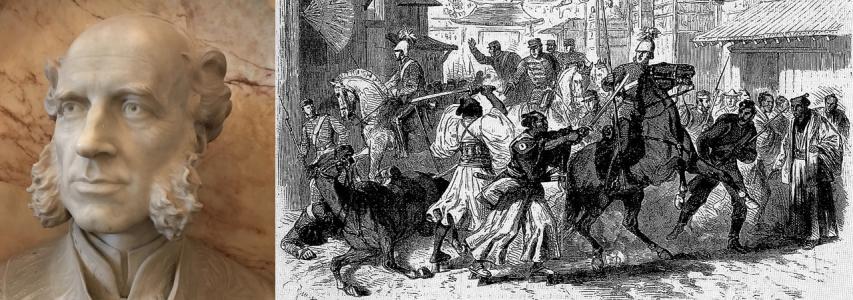
Bust of Sir Harry Parkes in St. Paul’s Cathedral in London © Robert Morton (left); Attack on the delegation of Sir Harry Smith Parkes to the Meiji Emperor, February 1868, from a drawing by Jules Brunet, Artillery Captain of the French Military Mission in Japan, "Le Monde Illustre", 13 June 1868 (right).
‘Singleness of purpose’: Sir Harry Parkes, British Minister to Japan, Korea and China, 1865-1885
- 14 November 2020
- 11:00am (GMT) / 8:00pm (JST)
- Online
- https://www.japansociety.org.uk/event?event=148&eventcat=5
- - - -
- events@japansociety.org.uk
- Tweet
Above is the bust of Sir Harry Parkes in St. Paul’s Cathedral in London. How did an orphan, who went on his own to China at 13, get a knighthood at 34, rise all the way up to Minister (equivalent to today’s Ambassador), and then receive this memorial?
Today, he is a hate figure in China and feelings are a little mixed about him in Japan, but nobody can deny the central role he played in the relations between East Asia and the West from the 1850s until the 1880s. He started early: at 14, he was present at the signing of the Treaty of Nanjing which gained Hong Kong for Britain. At twenty-eight, an argument he had with a few Chinese officials triggered the Second Opium War, leading to the collapse of a British government and the deaths of around 30,000 Chinese. In Japan, where he was Minister for 18 years, he played a key role in the ‘Meiji Restoration’ which saw the end of the feudal regime of the Shoguns and the beginning of a modern nation, ruled by a constitutional monarch. He was indomitable, fearless, incorruptible, often insufferable, always larger than life. In this illustrated talk, and a Q&A that follows, Robert Morton will attempt to bring him back to life for an hour or so, while introducing his new book, A Life of Sir Harry Parkes (Renaissance, 2020).
Dr Robert Morton is a professor at Chuo University in Tokyo. He is the author of A.B. Mitford and the Birth of Japan as a Modern State (Renaissance, 2017) which won the 5th Annual Kokkiken Study Award and the forthcoming A Life of Sir Harry Parkes.
If you have any questions, please call the Japan Society office on 020 3075 1996 or email us at: events@japansociety.org.
Booking Details
Online Event
Free - Booking essential
